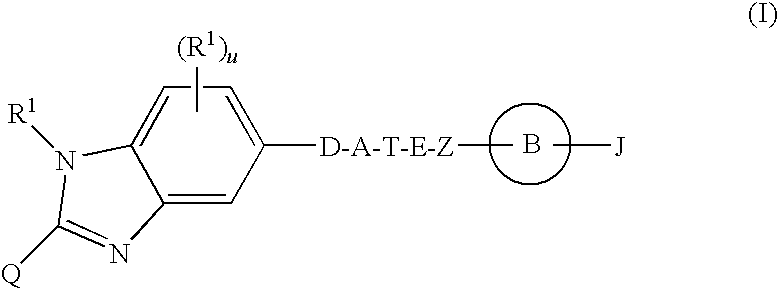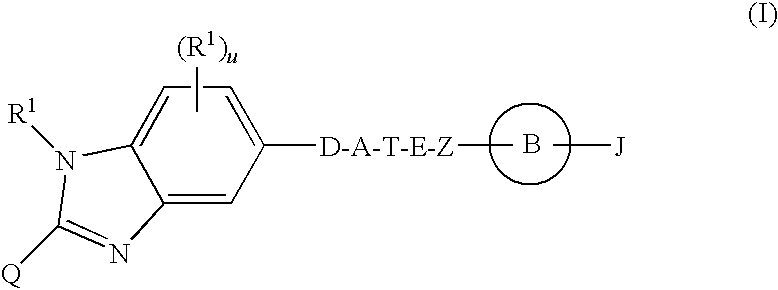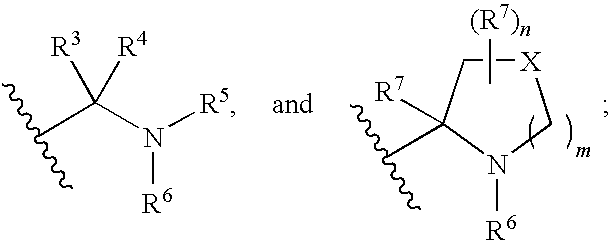Novel benzimidazole derivatives
a benzimidazole and derivative technology, applied in the field of new antiviral agents, can solve the problems of hcv genotype, less effective therapy against infections, and unlikely development of a successful vaccine in the near future, and achieve the effect of treating or prophylaxis of viral infections
- Summary
- Abstract
- Description
- Claims
- Application Information
AI Technical Summary
Benefits of technology
Problems solved by technology
Method used
Image
Examples
example 1
[0183]
[0184]Step 1a. A mixture of N-Boc-L-proline (5.754 g, 26.7 mmol) and TEA (3.73 mL, 26.7 mmol) in THF (60 mL) at −20° C. was treated with ethyl chloroformate (2.55 mL, 26.7 mmol) for 30 minutes before a slow addition of 4-bromo-1,2-diaminobenzene (5.00 g, 26.7 mmol) in THF (20 mL). It was then kept at −20° C. for 1 hour and then slowly warmed up to rt and stirred at rt overnight. The volatiles were evaporated and the residue was partitioned (EtOAc-water). The organics were washed with brine, dried (Na2SO4), filtered and evaporated to give the crude desired compound as a dark brown foam (10.7 g). ESIMS m / z=384.18, 386.18 [M+H]−.
[0185]Step 1b. A solution of the crude compound from step 1a (10.7 g, 26.7 mmol at most) in glacial acetic acid (100 mL) was heated at 50° C. for 2 hours. The volatiles were evaporated off and the residue was partitioned (EtOAc-aqueous NaHCO3). The organics were washed with brine, dried (Na2SO4), filtered and evaporated. The residue was purified by chroma...
example 2
[0191]
[0192]Step 2a. A solution of the compound of example 1 (20.0 mg, 33.4 μmol) in 1,4-dioxane (1 mL) was treated with HCl in 1,4-dioxane (4 M, 4 mL) at rt for 30 minutes. The volatiles were evaporated off to give the crude desired compound as a yellow solid which was directly used in the next step. ESIMS m / z=399.35 [M+H]+.
[0193]Step 2b. A mixture of the crude compound from step 2a (33.4 μmol at most) and (R)-(methoxycarbonyl)amino phenyl acetic acid (prepared according to WO 2008 / 021927, 20.9 mg, 0.100 mmol) in DMF (3 mL) was treated with HATU (31.7 mg, 83.5 μmol) in the presence of DIPEA (83.0 μL, 0.668 mmol) for 2 hours at rt and the volatiles were evaporated off to provide a brown sirup. It was purified by chromatography (silica, CH2Cl2-MeOH) to give the title compound as a yellow solid (23.8 mg, 2 steps 91%). ESIMS m / z=781.67 [M+H]+.
example 1-1
[0194]
[0195]Step 1-1a. A mixture of the compound from step 1d (0.559 g, 1.425 mmol), trimethylsilyl-acetylene (0.60 ml, 4.275 mmol), CuI (28.5 mg, 0.150 mmol) and Pd(PPh3)2Cl2 (80.0 mg, 0.114 mmol) in Et3N (15 mL) was heated at 80° C. under N2 for 6 hours before being evaporated. The residue was purified by chromatography (silica, hexanes-ethyl acetate with 1% Et3N in ethyl acetate) to give the desired compound as a yellow foam (0.484 g, 83%). ESIMS m / z=410.24 [M+H]+.
[0196]Step 1-1b. A suspension of the compound from step 1-1a (0.484 g, 1.182 mmol) and K2CO3 (0.408 g, 2.954 mmol) in methanol (12 ml) was stirred at rt for 3 hour. The volatiles were evaporated off. The residue was purified by chromatography (silica, dichloromethane-ethyl acetate) to give the desired compound as a yellow foam (0.370 g, 93%). ESIMS m / z=338.24 [M+H]+.
[0197]Step 1-1c. A mixture of the compound from step 1-1b (80.0 mg, 0.2371 mmol), the compound from step 1b (86.8 mg, 0.2371 mmol), CuI (2.2 mg, 0.01185 mmo...
PUM
| Property | Measurement | Unit |
|---|---|---|
| Fraction | aaaaa | aaaaa |
| Volume | aaaaa | aaaaa |
| Fraction | aaaaa | aaaaa |
Abstract
Description
Claims
Application Information
 Login to View More
Login to View More - R&D
- Intellectual Property
- Life Sciences
- Materials
- Tech Scout
- Unparalleled Data Quality
- Higher Quality Content
- 60% Fewer Hallucinations
Browse by: Latest US Patents, China's latest patents, Technical Efficacy Thesaurus, Application Domain, Technology Topic, Popular Technical Reports.
© 2025 PatSnap. All rights reserved.Legal|Privacy policy|Modern Slavery Act Transparency Statement|Sitemap|About US| Contact US: help@patsnap.com



